Data Mining and Visualization Report: Security, Privacy and Ethics
VerifiedAdded on 2020/03/13
|10
|2381
|40
Report
AI Summary
This report provides an in-depth analysis of data mining and visualization, covering various aspects relevant to businesses and data-driven applications. It begins with an introduction to data mining and its importance in modern businesses, highlighting its use in organizing and extracting valuable information from large datasets. The report then explores the application of data mining in different sectors, such as marketing, banking, and manufacturing. It includes an overview of Logic-ITA, a web-based information tool used in Sydney University, and its role in helping students practice formal logic proofs. The analysis section delves into critical issues in data mining, including security concerns, privacy issues, and ethical implications. The report examines the challenges of securing data, the importance of privacy, and the moral considerations for organizations using data mining. Furthermore, the report discusses human rights in the context of big data, addressing how human rights principles can be applied to data collection and usage. The conclusion summarizes the key findings and emphasizes the importance of data mining in business development, particularly in the context of data protection and ethical considerations. The report concludes with a list of references to support the presented information.
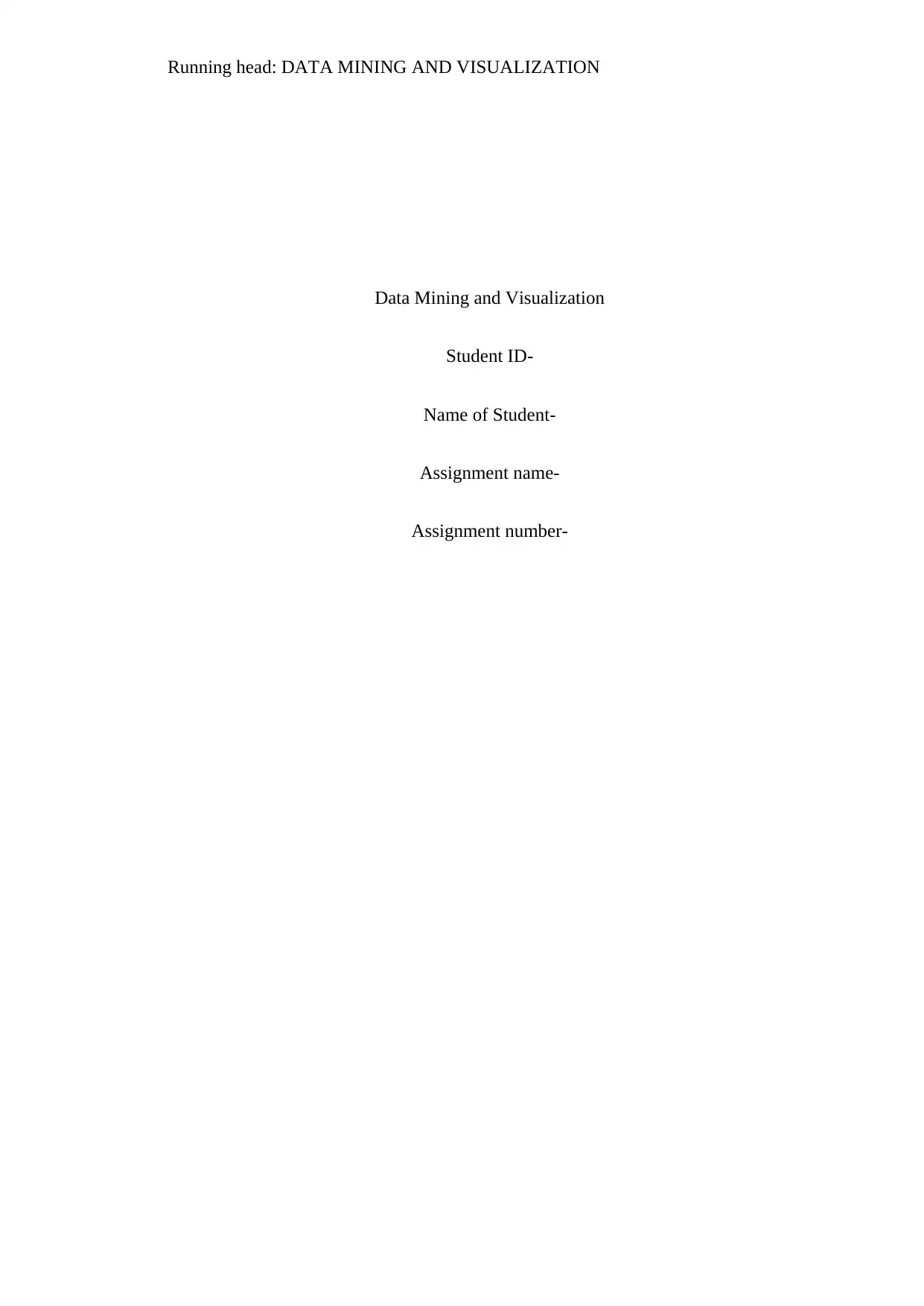
Running head: DATA MINING AND VISUALIZATION
Data Mining and Visualization
Student ID-
Name of Student-
Assignment name-
Assignment number-
Data Mining and Visualization
Student ID-
Name of Student-
Assignment name-
Assignment number-
Paraphrase This Document
Need a fresh take? Get an instant paraphrase of this document with our AI Paraphraser
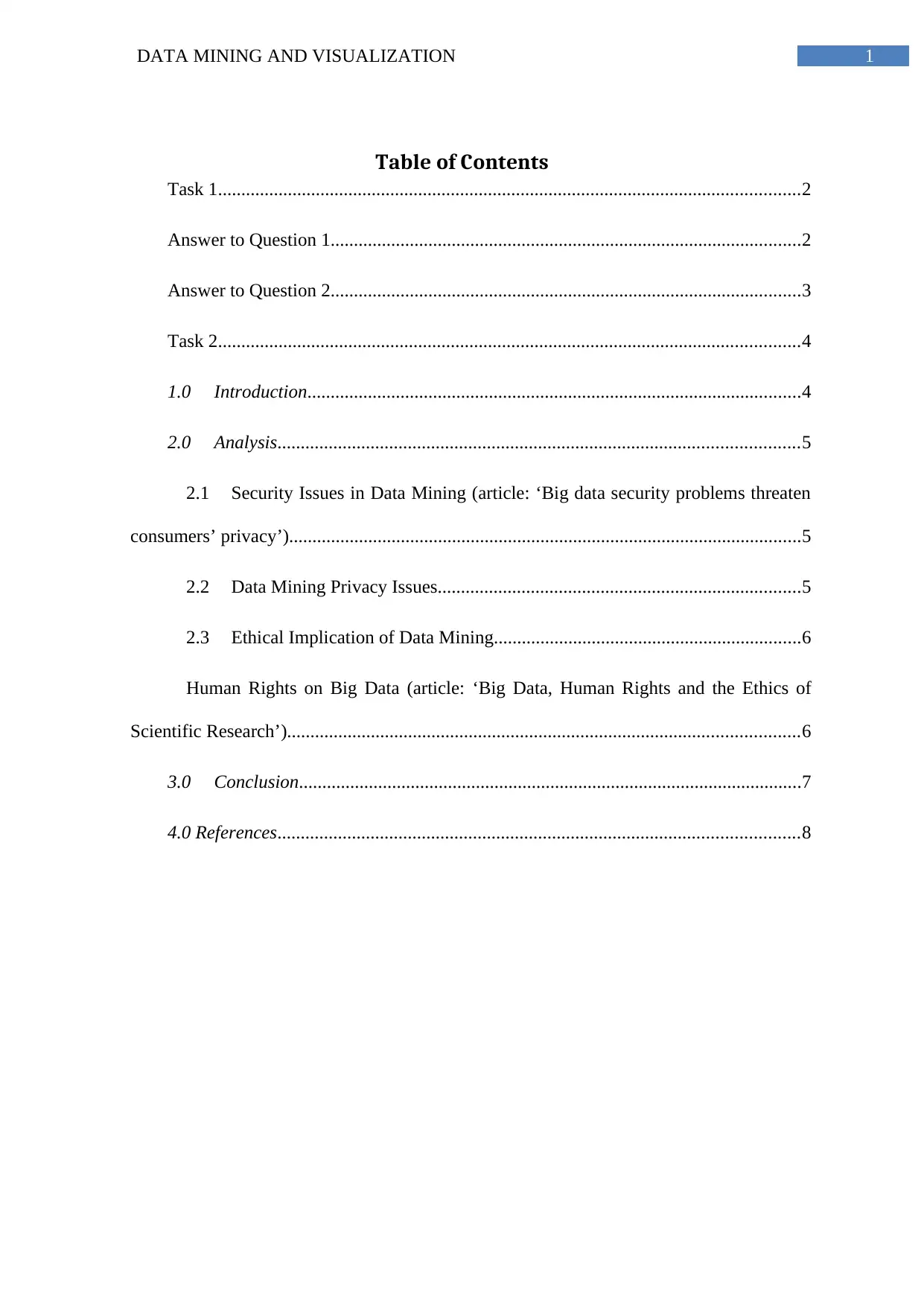
1DATA MINING AND VISUALIZATION
Table of Contents
Task 1.............................................................................................................................2
Answer to Question 1.....................................................................................................2
Answer to Question 2.....................................................................................................3
Task 2.............................................................................................................................4
1.0 Introduction..........................................................................................................4
2.0 Analysis................................................................................................................5
2.1 Security Issues in Data Mining (article: ‘Big data security problems threaten
consumers’ privacy’)..............................................................................................................5
2.2 Data Mining Privacy Issues..............................................................................5
2.3 Ethical Implication of Data Mining..................................................................6
Human Rights on Big Data (article: ‘Big Data, Human Rights and the Ethics of
Scientific Research’)..............................................................................................................6
3.0 Conclusion............................................................................................................7
4.0 References................................................................................................................8
Table of Contents
Task 1.............................................................................................................................2
Answer to Question 1.....................................................................................................2
Answer to Question 2.....................................................................................................3
Task 2.............................................................................................................................4
1.0 Introduction..........................................................................................................4
2.0 Analysis................................................................................................................5
2.1 Security Issues in Data Mining (article: ‘Big data security problems threaten
consumers’ privacy’)..............................................................................................................5
2.2 Data Mining Privacy Issues..............................................................................5
2.3 Ethical Implication of Data Mining..................................................................6
Human Rights on Big Data (article: ‘Big Data, Human Rights and the Ethics of
Scientific Research’)..............................................................................................................6
3.0 Conclusion............................................................................................................7
4.0 References................................................................................................................8
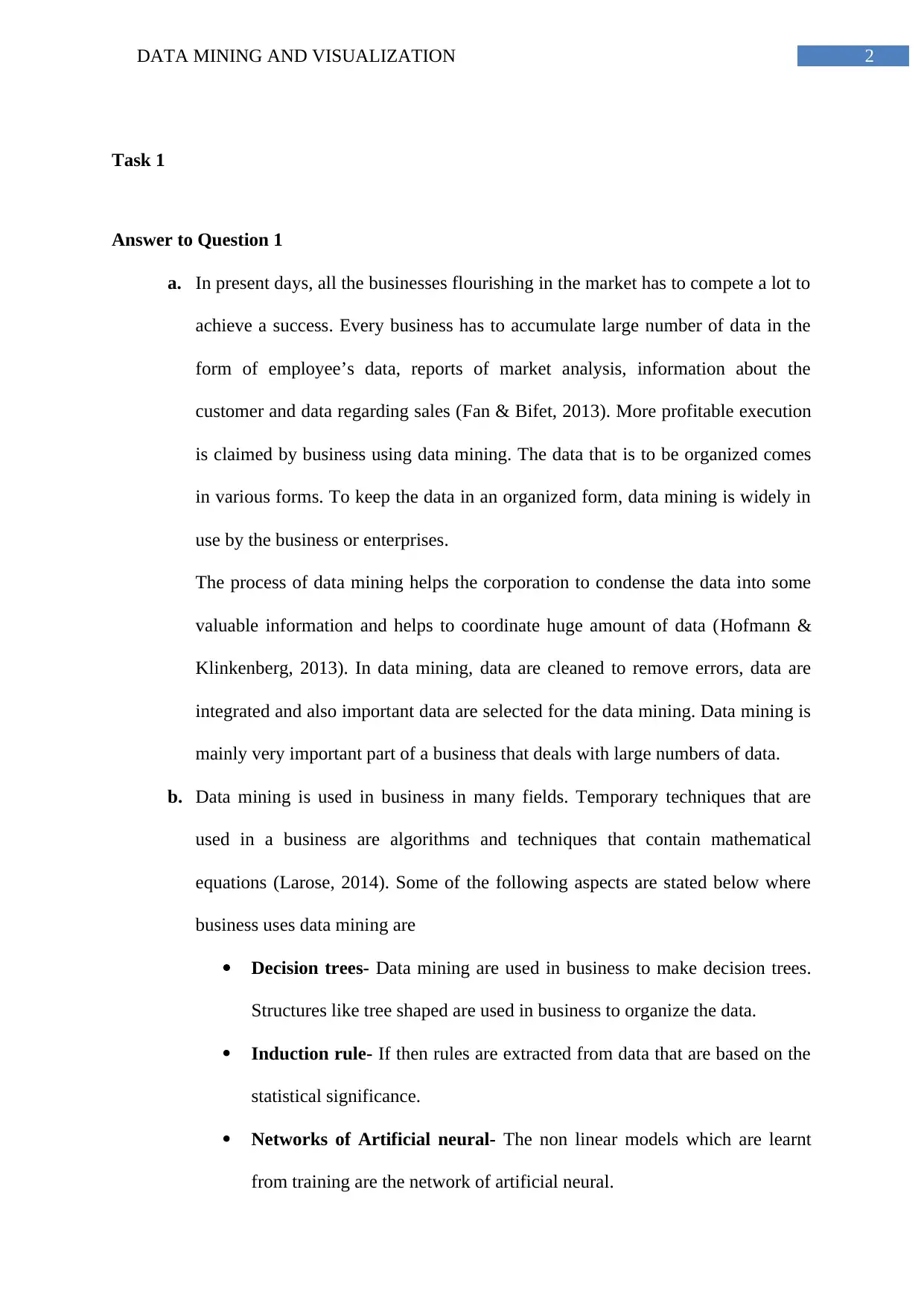
2DATA MINING AND VISUALIZATION
Task 1
Answer to Question 1
a. In present days, all the businesses flourishing in the market has to compete a lot to
achieve a success. Every business has to accumulate large number of data in the
form of employee’s data, reports of market analysis, information about the
customer and data regarding sales (Fan & Bifet, 2013). More profitable execution
is claimed by business using data mining. The data that is to be organized comes
in various forms. To keep the data in an organized form, data mining is widely in
use by the business or enterprises.
The process of data mining helps the corporation to condense the data into some
valuable information and helps to coordinate huge amount of data (Hofmann &
Klinkenberg, 2013). In data mining, data are cleaned to remove errors, data are
integrated and also important data are selected for the data mining. Data mining is
mainly very important part of a business that deals with large numbers of data.
b. Data mining is used in business in many fields. Temporary techniques that are
used in a business are algorithms and techniques that contain mathematical
equations (Larose, 2014). Some of the following aspects are stated below where
business uses data mining are
Decision trees- Data mining are used in business to make decision trees.
Structures like tree shaped are used in business to organize the data.
Induction rule- If then rules are extracted from data that are based on the
statistical significance.
Networks of Artificial neural- The non linear models which are learnt
from training are the network of artificial neural.
Task 1
Answer to Question 1
a. In present days, all the businesses flourishing in the market has to compete a lot to
achieve a success. Every business has to accumulate large number of data in the
form of employee’s data, reports of market analysis, information about the
customer and data regarding sales (Fan & Bifet, 2013). More profitable execution
is claimed by business using data mining. The data that is to be organized comes
in various forms. To keep the data in an organized form, data mining is widely in
use by the business or enterprises.
The process of data mining helps the corporation to condense the data into some
valuable information and helps to coordinate huge amount of data (Hofmann &
Klinkenberg, 2013). In data mining, data are cleaned to remove errors, data are
integrated and also important data are selected for the data mining. Data mining is
mainly very important part of a business that deals with large numbers of data.
b. Data mining is used in business in many fields. Temporary techniques that are
used in a business are algorithms and techniques that contain mathematical
equations (Larose, 2014). Some of the following aspects are stated below where
business uses data mining are
Decision trees- Data mining are used in business to make decision trees.
Structures like tree shaped are used in business to organize the data.
Induction rule- If then rules are extracted from data that are based on the
statistical significance.
Networks of Artificial neural- The non linear models which are learnt
from training are the network of artificial neural.
⊘ This is a preview!⊘
Do you want full access?
Subscribe today to unlock all pages.

Trusted by 1+ million students worldwide
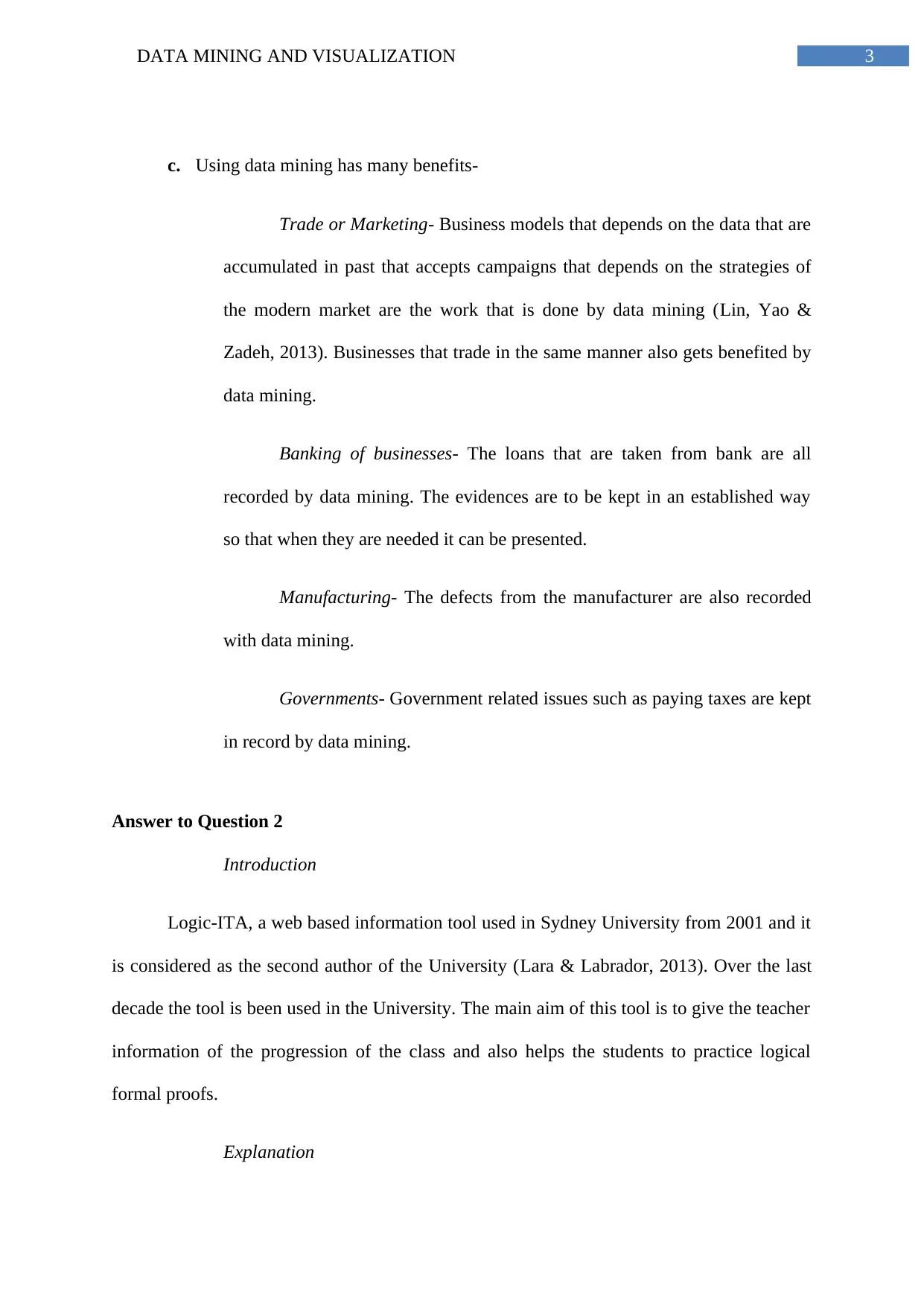
3DATA MINING AND VISUALIZATION
c. Using data mining has many benefits-
Trade or Marketing- Business models that depends on the data that are
accumulated in past that accepts campaigns that depends on the strategies of
the modern market are the work that is done by data mining (Lin, Yao &
Zadeh, 2013). Businesses that trade in the same manner also gets benefited by
data mining.
Banking of businesses- The loans that are taken from bank are all
recorded by data mining. The evidences are to be kept in an established way
so that when they are needed it can be presented.
Manufacturing- The defects from the manufacturer are also recorded
with data mining.
Governments- Government related issues such as paying taxes are kept
in record by data mining.
Answer to Question 2
Introduction
Logic-ITA, a web based information tool used in Sydney University from 2001 and it
is considered as the second author of the University (Lara & Labrador, 2013). Over the last
decade the tool is been used in the University. The main aim of this tool is to give the teacher
information of the progression of the class and also helps the students to practice logical
formal proofs.
Explanation
c. Using data mining has many benefits-
Trade or Marketing- Business models that depends on the data that are
accumulated in past that accepts campaigns that depends on the strategies of
the modern market are the work that is done by data mining (Lin, Yao &
Zadeh, 2013). Businesses that trade in the same manner also gets benefited by
data mining.
Banking of businesses- The loans that are taken from bank are all
recorded by data mining. The evidences are to be kept in an established way
so that when they are needed it can be presented.
Manufacturing- The defects from the manufacturer are also recorded
with data mining.
Governments- Government related issues such as paying taxes are kept
in record by data mining.
Answer to Question 2
Introduction
Logic-ITA, a web based information tool used in Sydney University from 2001 and it
is considered as the second author of the University (Lara & Labrador, 2013). Over the last
decade the tool is been used in the University. The main aim of this tool is to give the teacher
information of the progression of the class and also helps the students to practice logical
formal proofs.
Explanation
Paraphrase This Document
Need a fresh take? Get an instant paraphrase of this document with our AI Paraphraser
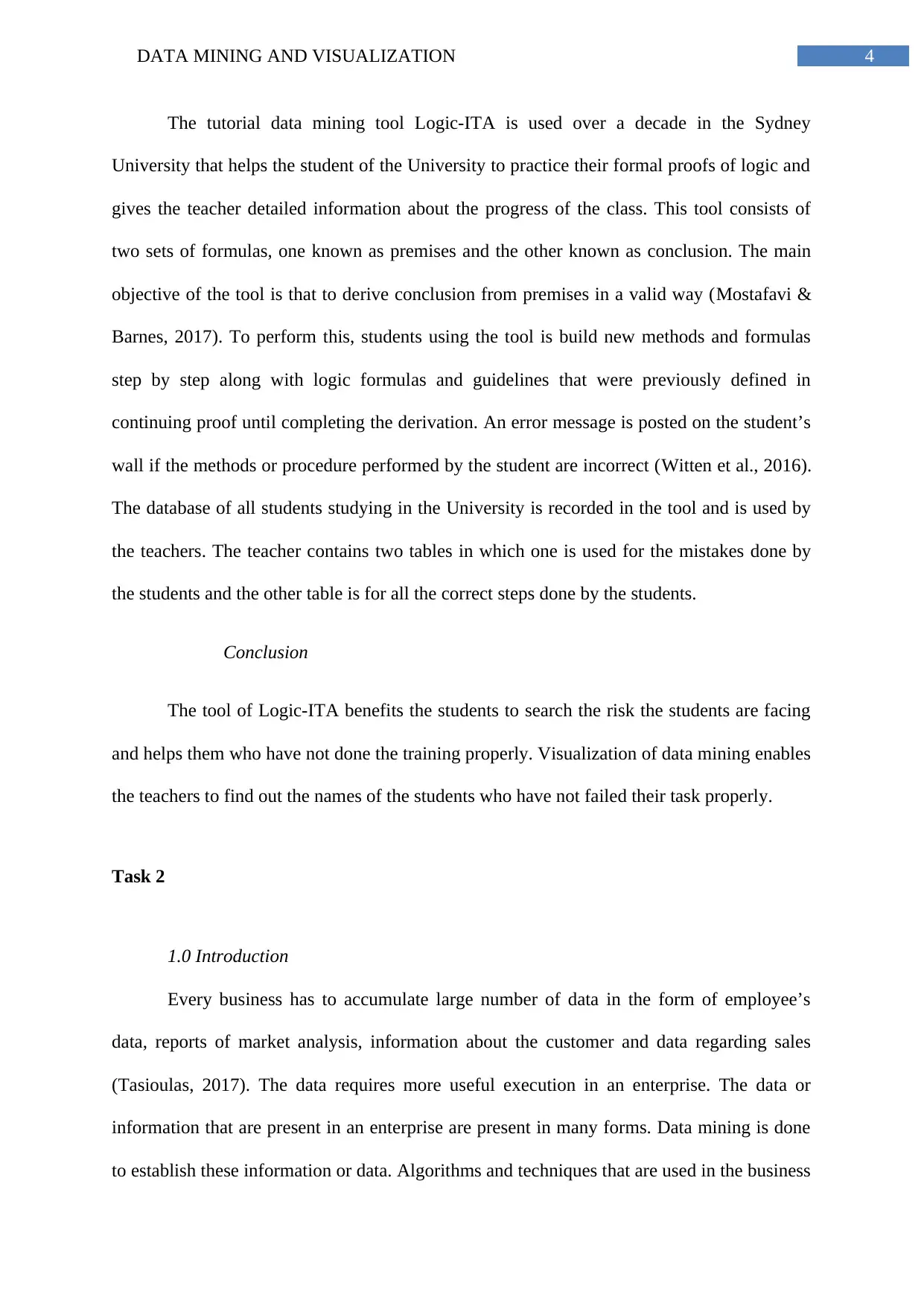
4DATA MINING AND VISUALIZATION
The tutorial data mining tool Logic-ITA is used over a decade in the Sydney
University that helps the student of the University to practice their formal proofs of logic and
gives the teacher detailed information about the progress of the class. This tool consists of
two sets of formulas, one known as premises and the other known as conclusion. The main
objective of the tool is that to derive conclusion from premises in a valid way (Mostafavi &
Barnes, 2017). To perform this, students using the tool is build new methods and formulas
step by step along with logic formulas and guidelines that were previously defined in
continuing proof until completing the derivation. An error message is posted on the student’s
wall if the methods or procedure performed by the student are incorrect (Witten et al., 2016).
The database of all students studying in the University is recorded in the tool and is used by
the teachers. The teacher contains two tables in which one is used for the mistakes done by
the students and the other table is for all the correct steps done by the students.
Conclusion
The tool of Logic-ITA benefits the students to search the risk the students are facing
and helps them who have not done the training properly. Visualization of data mining enables
the teachers to find out the names of the students who have not failed their task properly.
Task 2
1.0 Introduction
Every business has to accumulate large number of data in the form of employee’s
data, reports of market analysis, information about the customer and data regarding sales
(Tasioulas, 2017). The data requires more useful execution in an enterprise. The data or
information that are present in an enterprise are present in many forms. Data mining is done
to establish these information or data. Algorithms and techniques that are used in the business
The tutorial data mining tool Logic-ITA is used over a decade in the Sydney
University that helps the student of the University to practice their formal proofs of logic and
gives the teacher detailed information about the progress of the class. This tool consists of
two sets of formulas, one known as premises and the other known as conclusion. The main
objective of the tool is that to derive conclusion from premises in a valid way (Mostafavi &
Barnes, 2017). To perform this, students using the tool is build new methods and formulas
step by step along with logic formulas and guidelines that were previously defined in
continuing proof until completing the derivation. An error message is posted on the student’s
wall if the methods or procedure performed by the student are incorrect (Witten et al., 2016).
The database of all students studying in the University is recorded in the tool and is used by
the teachers. The teacher contains two tables in which one is used for the mistakes done by
the students and the other table is for all the correct steps done by the students.
Conclusion
The tool of Logic-ITA benefits the students to search the risk the students are facing
and helps them who have not done the training properly. Visualization of data mining enables
the teachers to find out the names of the students who have not failed their task properly.
Task 2
1.0 Introduction
Every business has to accumulate large number of data in the form of employee’s
data, reports of market analysis, information about the customer and data regarding sales
(Tasioulas, 2017). The data requires more useful execution in an enterprise. The data or
information that are present in an enterprise are present in many forms. Data mining is done
to establish these information or data. Algorithms and techniques that are used in the business
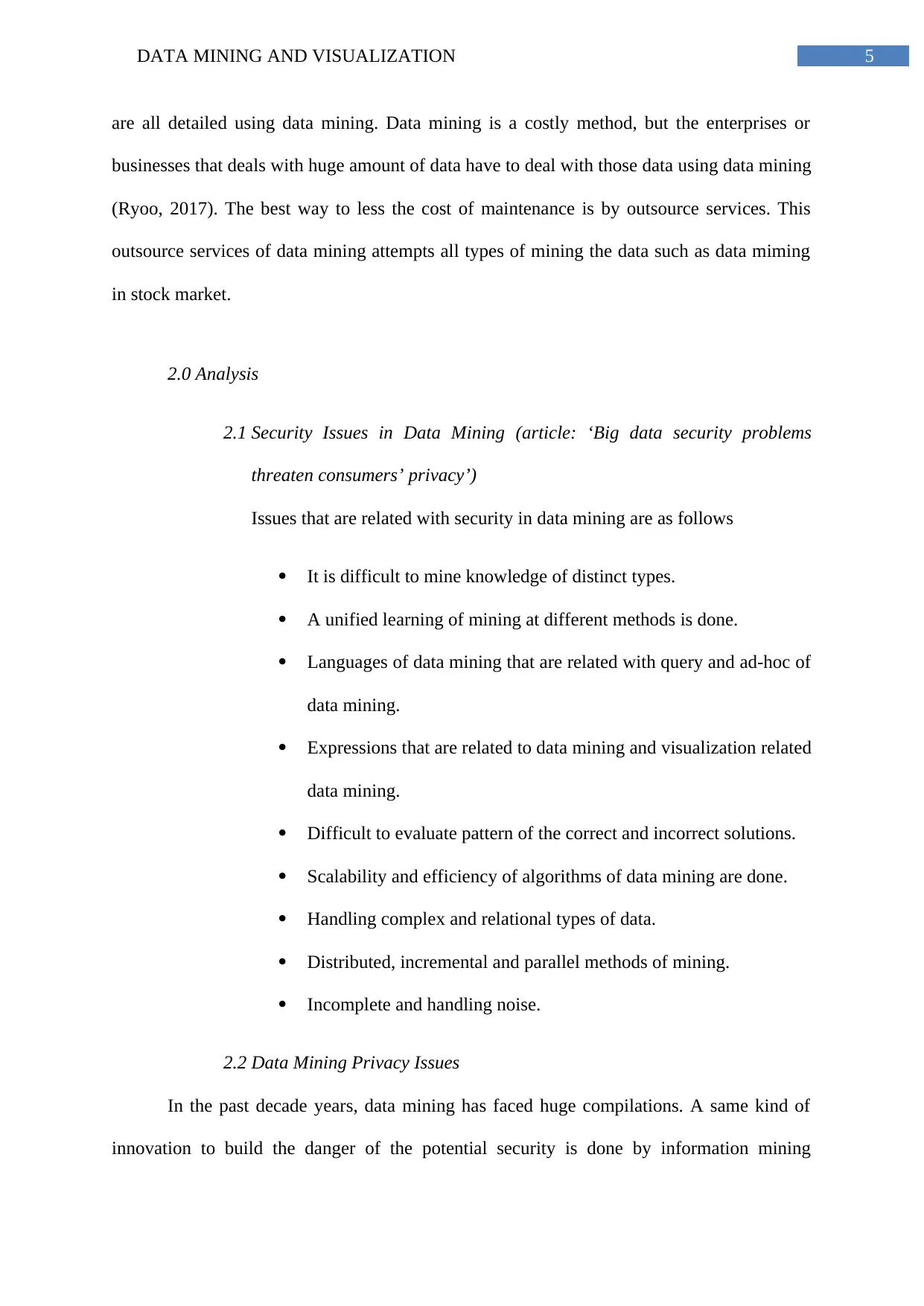
5DATA MINING AND VISUALIZATION
are all detailed using data mining. Data mining is a costly method, but the enterprises or
businesses that deals with huge amount of data have to deal with those data using data mining
(Ryoo, 2017). The best way to less the cost of maintenance is by outsource services. This
outsource services of data mining attempts all types of mining the data such as data miming
in stock market.
2.0 Analysis
2.1 Security Issues in Data Mining (article: ‘Big data security problems
threaten consumers’ privacy’)
Issues that are related with security in data mining are as follows
It is difficult to mine knowledge of distinct types.
A unified learning of mining at different methods is done.
Languages of data mining that are related with query and ad-hoc of
data mining.
Expressions that are related to data mining and visualization related
data mining.
Difficult to evaluate pattern of the correct and incorrect solutions.
Scalability and efficiency of algorithms of data mining are done.
Handling complex and relational types of data.
Distributed, incremental and parallel methods of mining.
Incomplete and handling noise.
2.2 Data Mining Privacy Issues
In the past decade years, data mining has faced huge compilations. A same kind of
innovation to build the danger of the potential security is done by information mining
are all detailed using data mining. Data mining is a costly method, but the enterprises or
businesses that deals with huge amount of data have to deal with those data using data mining
(Ryoo, 2017). The best way to less the cost of maintenance is by outsource services. This
outsource services of data mining attempts all types of mining the data such as data miming
in stock market.
2.0 Analysis
2.1 Security Issues in Data Mining (article: ‘Big data security problems
threaten consumers’ privacy’)
Issues that are related with security in data mining are as follows
It is difficult to mine knowledge of distinct types.
A unified learning of mining at different methods is done.
Languages of data mining that are related with query and ad-hoc of
data mining.
Expressions that are related to data mining and visualization related
data mining.
Difficult to evaluate pattern of the correct and incorrect solutions.
Scalability and efficiency of algorithms of data mining are done.
Handling complex and relational types of data.
Distributed, incremental and parallel methods of mining.
Incomplete and handling noise.
2.2 Data Mining Privacy Issues
In the past decade years, data mining has faced huge compilations. A same kind of
innovation to build the danger of the potential security is done by information mining
⊘ This is a preview!⊘
Do you want full access?
Subscribe today to unlock all pages.

Trusted by 1+ million students worldwide
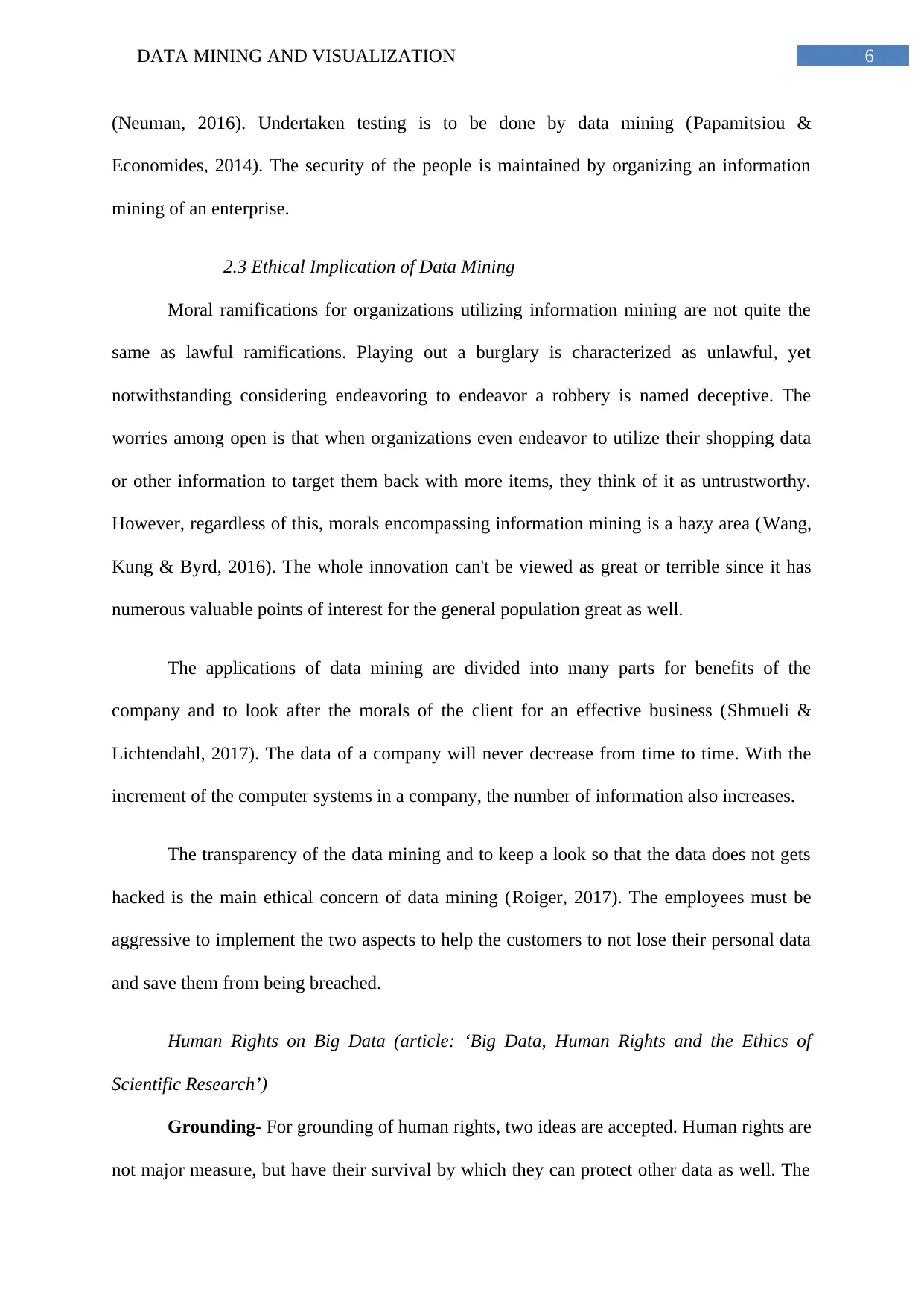
6DATA MINING AND VISUALIZATION
(Neuman, 2016). Undertaken testing is to be done by data mining (Papamitsiou &
Economides, 2014). The security of the people is maintained by organizing an information
mining of an enterprise.
2.3 Ethical Implication of Data Mining
Moral ramifications for organizations utilizing information mining are not quite the
same as lawful ramifications. Playing out a burglary is characterized as unlawful, yet
notwithstanding considering endeavoring to endeavor a robbery is named deceptive. The
worries among open is that when organizations even endeavor to utilize their shopping data
or other information to target them back with more items, they think of it as untrustworthy.
However, regardless of this, morals encompassing information mining is a hazy area (Wang,
Kung & Byrd, 2016). The whole innovation can't be viewed as great or terrible since it has
numerous valuable points of interest for the general population great as well.
The applications of data mining are divided into many parts for benefits of the
company and to look after the morals of the client for an effective business (Shmueli &
Lichtendahl, 2017). The data of a company will never decrease from time to time. With the
increment of the computer systems in a company, the number of information also increases.
The transparency of the data mining and to keep a look so that the data does not gets
hacked is the main ethical concern of data mining (Roiger, 2017). The employees must be
aggressive to implement the two aspects to help the customers to not lose their personal data
and save them from being breached.
Human Rights on Big Data (article: ‘Big Data, Human Rights and the Ethics of
Scientific Research’)
Grounding- For grounding of human rights, two ideas are accepted. Human rights are
not major measure, but have their survival by which they can protect other data as well. The
(Neuman, 2016). Undertaken testing is to be done by data mining (Papamitsiou &
Economides, 2014). The security of the people is maintained by organizing an information
mining of an enterprise.
2.3 Ethical Implication of Data Mining
Moral ramifications for organizations utilizing information mining are not quite the
same as lawful ramifications. Playing out a burglary is characterized as unlawful, yet
notwithstanding considering endeavoring to endeavor a robbery is named deceptive. The
worries among open is that when organizations even endeavor to utilize their shopping data
or other information to target them back with more items, they think of it as untrustworthy.
However, regardless of this, morals encompassing information mining is a hazy area (Wang,
Kung & Byrd, 2016). The whole innovation can't be viewed as great or terrible since it has
numerous valuable points of interest for the general population great as well.
The applications of data mining are divided into many parts for benefits of the
company and to look after the morals of the client for an effective business (Shmueli &
Lichtendahl, 2017). The data of a company will never decrease from time to time. With the
increment of the computer systems in a company, the number of information also increases.
The transparency of the data mining and to keep a look so that the data does not gets
hacked is the main ethical concern of data mining (Roiger, 2017). The employees must be
aggressive to implement the two aspects to help the customers to not lose their personal data
and save them from being breached.
Human Rights on Big Data (article: ‘Big Data, Human Rights and the Ethics of
Scientific Research’)
Grounding- For grounding of human rights, two ideas are accepted. Human rights are
not major measure, but have their survival by which they can protect other data as well. The
Paraphrase This Document
Need a fresh take? Get an instant paraphrase of this document with our AI Paraphraser
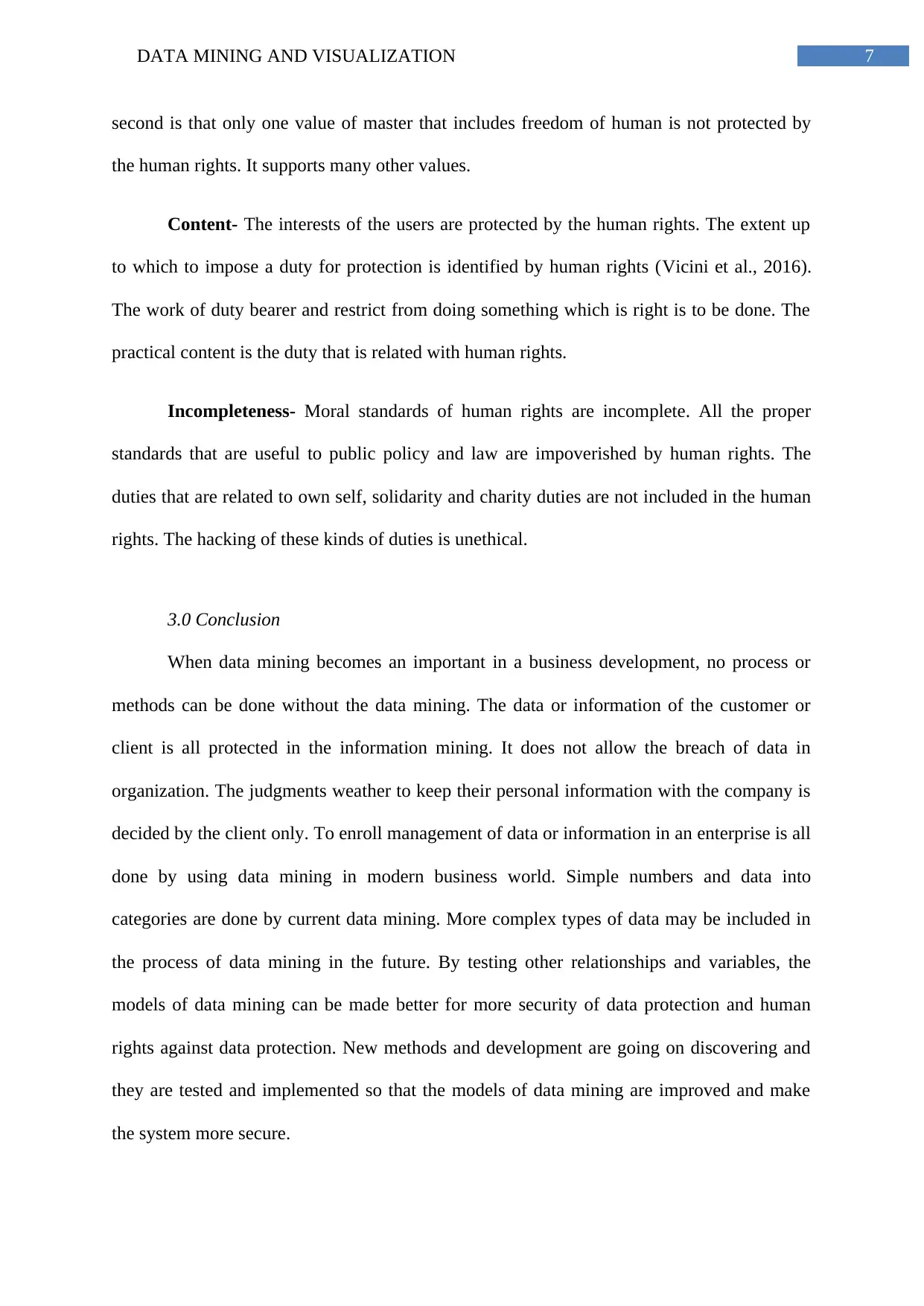
7DATA MINING AND VISUALIZATION
second is that only one value of master that includes freedom of human is not protected by
the human rights. It supports many other values.
Content- The interests of the users are protected by the human rights. The extent up
to which to impose a duty for protection is identified by human rights (Vicini et al., 2016).
The work of duty bearer and restrict from doing something which is right is to be done. The
practical content is the duty that is related with human rights.
Incompleteness- Moral standards of human rights are incomplete. All the proper
standards that are useful to public policy and law are impoverished by human rights. The
duties that are related to own self, solidarity and charity duties are not included in the human
rights. The hacking of these kinds of duties is unethical.
3.0 Conclusion
When data mining becomes an important in a business development, no process or
methods can be done without the data mining. The data or information of the customer or
client is all protected in the information mining. It does not allow the breach of data in
organization. The judgments weather to keep their personal information with the company is
decided by the client only. To enroll management of data or information in an enterprise is all
done by using data mining in modern business world. Simple numbers and data into
categories are done by current data mining. More complex types of data may be included in
the process of data mining in the future. By testing other relationships and variables, the
models of data mining can be made better for more security of data protection and human
rights against data protection. New methods and development are going on discovering and
they are tested and implemented so that the models of data mining are improved and make
the system more secure.
second is that only one value of master that includes freedom of human is not protected by
the human rights. It supports many other values.
Content- The interests of the users are protected by the human rights. The extent up
to which to impose a duty for protection is identified by human rights (Vicini et al., 2016).
The work of duty bearer and restrict from doing something which is right is to be done. The
practical content is the duty that is related with human rights.
Incompleteness- Moral standards of human rights are incomplete. All the proper
standards that are useful to public policy and law are impoverished by human rights. The
duties that are related to own self, solidarity and charity duties are not included in the human
rights. The hacking of these kinds of duties is unethical.
3.0 Conclusion
When data mining becomes an important in a business development, no process or
methods can be done without the data mining. The data or information of the customer or
client is all protected in the information mining. It does not allow the breach of data in
organization. The judgments weather to keep their personal information with the company is
decided by the client only. To enroll management of data or information in an enterprise is all
done by using data mining in modern business world. Simple numbers and data into
categories are done by current data mining. More complex types of data may be included in
the process of data mining in the future. By testing other relationships and variables, the
models of data mining can be made better for more security of data protection and human
rights against data protection. New methods and development are going on discovering and
they are tested and implemented so that the models of data mining are improved and make
the system more secure.
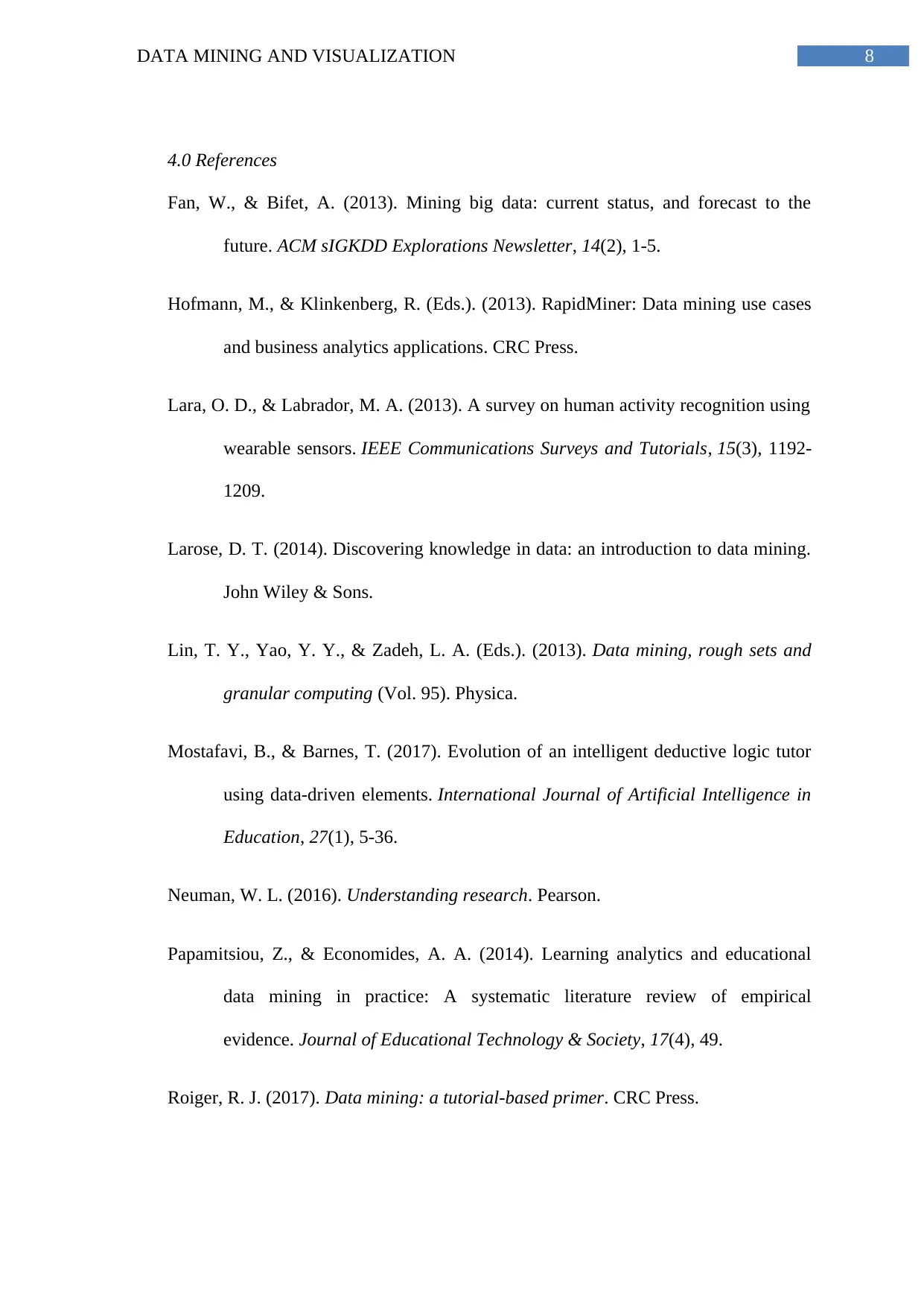
8DATA MINING AND VISUALIZATION
4.0 References
Fan, W., & Bifet, A. (2013). Mining big data: current status, and forecast to the
future. ACM sIGKDD Explorations Newsletter, 14(2), 1-5.
Hofmann, M., & Klinkenberg, R. (Eds.). (2013). RapidMiner: Data mining use cases
and business analytics applications. CRC Press.
Lara, O. D., & Labrador, M. A. (2013). A survey on human activity recognition using
wearable sensors. IEEE Communications Surveys and Tutorials, 15(3), 1192-
1209.
Larose, D. T. (2014). Discovering knowledge in data: an introduction to data mining.
John Wiley & Sons.
Lin, T. Y., Yao, Y. Y., & Zadeh, L. A. (Eds.). (2013). Data mining, rough sets and
granular computing (Vol. 95). Physica.
Mostafavi, B., & Barnes, T. (2017). Evolution of an intelligent deductive logic tutor
using data-driven elements. International Journal of Artificial Intelligence in
Education, 27(1), 5-36.
Neuman, W. L. (2016). Understanding research. Pearson.
Papamitsiou, Z., & Economides, A. A. (2014). Learning analytics and educational
data mining in practice: A systematic literature review of empirical
evidence. Journal of Educational Technology & Society, 17(4), 49.
Roiger, R. J. (2017). Data mining: a tutorial-based primer. CRC Press.
4.0 References
Fan, W., & Bifet, A. (2013). Mining big data: current status, and forecast to the
future. ACM sIGKDD Explorations Newsletter, 14(2), 1-5.
Hofmann, M., & Klinkenberg, R. (Eds.). (2013). RapidMiner: Data mining use cases
and business analytics applications. CRC Press.
Lara, O. D., & Labrador, M. A. (2013). A survey on human activity recognition using
wearable sensors. IEEE Communications Surveys and Tutorials, 15(3), 1192-
1209.
Larose, D. T. (2014). Discovering knowledge in data: an introduction to data mining.
John Wiley & Sons.
Lin, T. Y., Yao, Y. Y., & Zadeh, L. A. (Eds.). (2013). Data mining, rough sets and
granular computing (Vol. 95). Physica.
Mostafavi, B., & Barnes, T. (2017). Evolution of an intelligent deductive logic tutor
using data-driven elements. International Journal of Artificial Intelligence in
Education, 27(1), 5-36.
Neuman, W. L. (2016). Understanding research. Pearson.
Papamitsiou, Z., & Economides, A. A. (2014). Learning analytics and educational
data mining in practice: A systematic literature review of empirical
evidence. Journal of Educational Technology & Society, 17(4), 49.
Roiger, R. J. (2017). Data mining: a tutorial-based primer. CRC Press.
⊘ This is a preview!⊘
Do you want full access?
Subscribe today to unlock all pages.

Trusted by 1+ million students worldwide
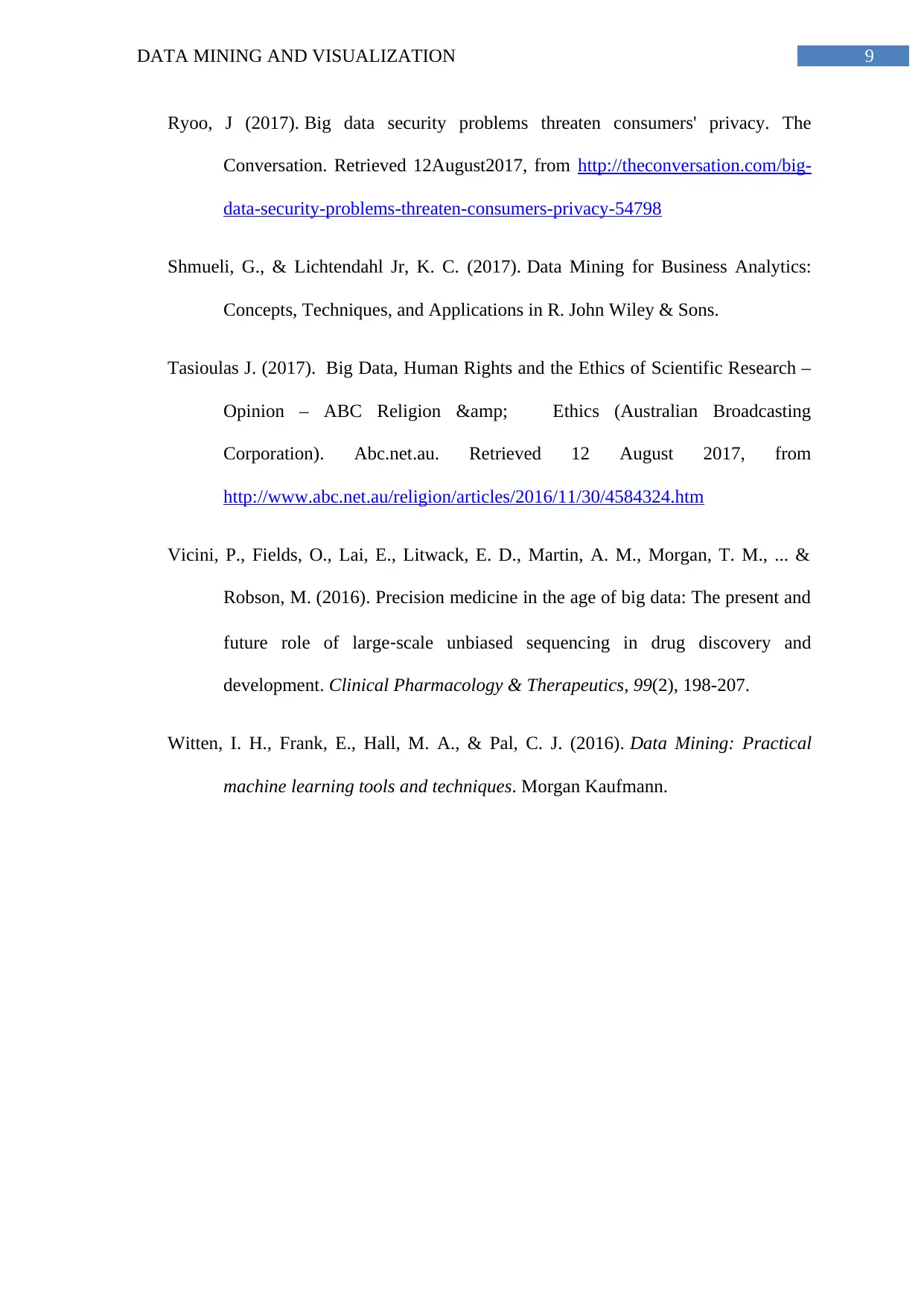
9DATA MINING AND VISUALIZATION
Ryoo, J (2017). Big data security problems threaten consumers' privacy. The
Conversation. Retrieved 12August2017, from http://theconversation.com/big-
data-security-problems-threaten-consumers-privacy-54798
Shmueli, G., & Lichtendahl Jr, K. C. (2017). Data Mining for Business Analytics:
Concepts, Techniques, and Applications in R. John Wiley & Sons.
Tasioulas J. (2017). Big Data, Human Rights and the Ethics of Scientific Research –
Opinion – ABC Religion & Ethics (Australian Broadcasting
Corporation). Abc.net.au. Retrieved 12 August 2017, from
http://www.abc.net.au/religion/articles/2016/11/30/4584324.htm
Vicini, P., Fields, O., Lai, E., Litwack, E. D., Martin, A. M., Morgan, T. M., ... &
Robson, M. (2016). Precision medicine in the age of big data: The present and
future role of large‐scale unbiased sequencing in drug discovery and
development. Clinical Pharmacology & Therapeutics, 99(2), 198-207.
Witten, I. H., Frank, E., Hall, M. A., & Pal, C. J. (2016). Data Mining: Practical
machine learning tools and techniques. Morgan Kaufmann.
Ryoo, J (2017). Big data security problems threaten consumers' privacy. The
Conversation. Retrieved 12August2017, from http://theconversation.com/big-
data-security-problems-threaten-consumers-privacy-54798
Shmueli, G., & Lichtendahl Jr, K. C. (2017). Data Mining for Business Analytics:
Concepts, Techniques, and Applications in R. John Wiley & Sons.
Tasioulas J. (2017). Big Data, Human Rights and the Ethics of Scientific Research –
Opinion – ABC Religion & Ethics (Australian Broadcasting
Corporation). Abc.net.au. Retrieved 12 August 2017, from
http://www.abc.net.au/religion/articles/2016/11/30/4584324.htm
Vicini, P., Fields, O., Lai, E., Litwack, E. D., Martin, A. M., Morgan, T. M., ... &
Robson, M. (2016). Precision medicine in the age of big data: The present and
future role of large‐scale unbiased sequencing in drug discovery and
development. Clinical Pharmacology & Therapeutics, 99(2), 198-207.
Witten, I. H., Frank, E., Hall, M. A., & Pal, C. J. (2016). Data Mining: Practical
machine learning tools and techniques. Morgan Kaufmann.
1 out of 10
Related Documents
Your All-in-One AI-Powered Toolkit for Academic Success.
+13062052269
info@desklib.com
Available 24*7 on WhatsApp / Email
![[object Object]](/_next/static/media/star-bottom.7253800d.svg)
Unlock your academic potential
Copyright © 2020–2025 A2Z Services. All Rights Reserved. Developed and managed by ZUCOL.





